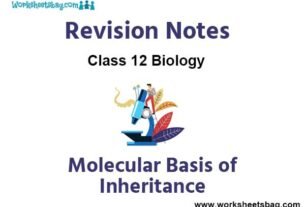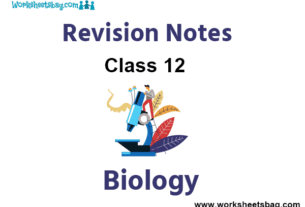Please refer to the Organisms and Populations Notes Class 12 Biology given below. These revision notes have been designed as per the latest NCERT, CBSE, and KVS books issued for the current academic year. Students will be able to understand the entire chapter in your class 12th Biology book. We have provided chapter-wise Notes for Class 12 Biology as per the latest examination pattern.
Revision Notes Chapter 13 Organisms and Populations Class 12 Biology
Students of Class 12 Biology will be able to revise the entire chapter and also learn all important concepts based on the topic-wise notes given below. Our best teachers for Grade 12 have prepared these to help you get better marks in upcoming examinations. These revision notes cover all important topics given in this chapter.
- The term ‘ecology’ is derived from two Greek words-oikos means ‘house or place to live’ and logos means ‘a discussion or study’.
- The German biologist Ernst Haeckel (1869) is credited for the coinage of the term ecology.
- Ecology may be defined broadly as the science of interrelation between living organisms and their environments including both the physical and biotic environments.
- The aquatic ecology includes freshwater ecology, eustuarine ecology and marine ecology.
- Terrestrial ecology is subdivided further into forest ecology, grassland ecology, cropland ecology and desert ecology. Ecology is basically concerned with various levels of biological organisation – organisms, populations, communities, ecosystems and biomes.
- Population is a group of individuals of the same species living together in a common area at a particular time. The different populations of the same kind of organisms are often referred to as local population.
- Members of a local population may be genetically adapted to their specific environment, such a population is called ecotype.
- Biotic community is an assemblage of populations of different species of plants, animals, bacteria and fungi which live in a particular area and interact with one another through competition, predation, mutualism, etc.
- Ecosystem is a segment of nature consisting of a biological community and its physical environment both interacting and exchanging materials as well as energy.
- Landscape is a unit of land distinguished by a natural boundary and having patches of different ecosystems, e.g., Southern peninsula.
- Biome is a large regional unit delimited by a specific climatic zone, having a particular major vegetation zone and its associated fauna, e.g., tundra desert, temperate deciduous forest , tropical rain forest, ocean.
- Biosphere is biologically inhabited part of earth along with its physical environment onsisting of lower atmosphere, land and water bodies.
Major biomes and their characteristics

ORGANISMS AND ITS ENVIRONMENT
- No organism can live alone. It has to interact with its immediate surroundings which include both biotic and abiotic factors.
- Environment is the sum total of all biotic and abiotic factors, substances and conditions that surround and potentially influence organisms without becoming their constituent part.
- Climate is a long term property of the atmosphere which is the same over a larger area and remains the same over a long period of time. Climate determines the flora and fauna of a place.
- Microclimate refers to the climatic conditions present at local scale i.e., within an area of limited size.
- Habitat is a specific place or locality delimited by a combination of factors, physical features and barriers where a community resides.
- Microhabitat is a part of the habitat having a specific property, e.g., forest floor, tree canopy, tree trunk, edge of a pond.
- Niche or ecological niche (Grinnel, 1917) is a specific part of habitat occupied by individuals of a species which is circumscribed by its range of tolerance, range of movement, microclimate, type of food and its availability, shelter, type of predator, and timing of activity. In other words, ecological niche means the total interaction of a species with its environment, or its functional position or status in an ecosystem.
- Ecological niche depends on the species’ structural adaptations, physical responses and behaviour.
- Any external thing, substance or condition which has eThect on living organism is called ecological factor and totality of all these factors constitute environmental complex or environment. There are four major types of factors:
Climatic factors : These are related to climate like, light, temperature, humidity, precipitation, wind, atmosphere and fire.
Topographic factors : These are related with physical geography of earth and are also called physiographic factors, e.g., altitude, direction of mountain and valleys, etc.
Edaphic or soil factors : These factors aThect through soil.
Biotic or living factors : Living organisms have eThect on other organisms and these constitute biotic factors.
Abiotic Factors:
Light
- Light is important ecological factor as it aThects different physiological processes of plants, e.g., photosynthesis, transpiration, movements, flowering, seed germination, etc.
- Light is responsible for daily rhythm in animals. Photoperiodism controls migration in birds, hibernation and breeding in animals whereas in plants it controls flowering and vegetative growth.
Temperature
Not only the physiological functions but also the geographical distribution of many plants and animals is governed by temperature. It influences the living organisms in the following manner:
Metabolic activities : different metabolic activities of plants are controlled by different enzymes which are aThected by temperature hence these metabolic activities are aThected by temperature, e.g., photosynthesis, respiration, etc.
Flowering in plants : Temperature is also an important factor aThecting flowering in plants. Low temperature treatment (0-6°C), i.e., vernalisation is responsible for enhancing flowering in plants.
Growth and development : Growth and development are adversely aThected by very low and high temperatures.
Water
- Water is an important component of protoplasm being used as a general solvent, a reactant, a metabolic by-product and an essential material for maintaining turgidity. Water is a resource, a condition and a habitat in itself. The productivity and distribution of plants is also heavily dependent on water.
- Plants of aquatic habitats are called hydrophytes. For aquatic organisms the quality (chemical composition, pH) of water is important. Mesophytes are plants of moist habitats whereas xerophytes are plants of dry habitats.
- Some organisms are tolerant of a wide range of salinities (euryhaline, e.g., salmon) but others are restricted to a narrow range of salinities (stenohaline, e.g., shark). Many freshwater animals cannot live for long in sea water and vice versa because of the osmotic problems they would face.
Soil
- Soil is very important ecological factor as it provides water, minerals or nutrients and support to the producers (plants).
- Mineral particles are the chief components of soil complex and are formed by weathering of rocks. Depending upon size of mineral particles, soils are of following types :
Clay : If particle size is less than 0.002 mm
Silt : If particle size is 0.002-0.02 mm
Fine sand : If the particle size is 0.02-0.2 mm
Coarse sand : 0.2-2 mm
Gravel or Stone : More than 2 mm - The appearance of different layers superposed one above the other in a vertical section of soil from surface downward to the parent rock is called soil profile.
- The horizons of soil are O, A, B and C. Unbroken and unweathered parent bed rock lies below C horizon.
Responses to Abiotic Factors
- A process by which the organism keeps the internal environment constant despite drastic changes in external conditions is called homeostasis.
- Regulators : Some organisms are able to maintain a constant body temperature and constant osmotic concentration despite changes in the external environment. They are called as regulators.
- Conformers : Organisms whose body temperature changes with the surrounding temperature (ectotherms) are called conformers. In aquatic animals and plants the osmotic concentration and temperature of body changes according to ambient conditions of water are also called conformers.
- Some species are partial regulators. They have the ability to regulate body functions to a limited extent. Beyond that limit they become conformers.
- Migration : The organisms can migrate temporarily from the unfavourable habitat to more favourable area and return when unfavourable period is over.
- Suspension : Various kinds of thick-walled spores are formed in bacteria, fungi and lower plants which help them survive under unfavourable conditions. These germinate on return of suitable conditions.
- In animals, the organism, if unable to migrate, might avoid the unfavourable environment by escaping in time. For example, polar bears go into hibernation during winter season to escape extreme cold. Some snails and fish undergo aestivation to avoid summer-related problems like heat and desiccation. Under favourable conditions many zooplankton in lakes and ponds are known to enter diapause i.e., a stage of suspended development.
- Adaptation is any attribute of the organism (morphological, physiological behavioural that enables it to survive and reproduce in its habitat.
- Plants that are adapted to bright sunlight are called sun plants or heliophytes.
- Plants which grow in partial shade or low intensity light are called shade plants or sciophytes.

POPULATION
- The term population has its origin in the Latin word populus, meaning people. In ecology, a population may be defined as a group of organisms of the same species occupying a particular space in a given time. The ultimate constituents of the population are individual organisms that can potentially interbreed.
- Study of population size is called demography. Study of human population in a given area likevillage, city etc. is called human demography.
- All aspects of a population including density, size, natality, mortality, immigration, emigration etc. is called population ecology.
Physical characteristics of a population
- The basic characteristic of a population is its size or density (number of individuals present per unit space in a given time) which is aThected by four primary population parameters such as natality, mortality, immigration and emigration.
- Natality/Birth rate : Number of organisms born per unit population per unit time.
1.Natality rate depends on biotic potential i.e., ability to produce young ones.
2.Total fertility rate (TFR) : Total number of offspring born per female during her life time. - Mortality rate / Death rate : Number of death per unit population per unit time.
- Migration : Movement of individuals in or out of population is called migration. It may be in order to get food, space, shelter, job, to avoid predator, etc. It is of two types:
Emigration : It refers to moving out of individuals. It results in decrease of population size.
Immigration : It refers to moving in of individuals. It results in increase in population size.


Population growth forms
Every population has a specific growth form i.e., characteristic pattern of increase. There are 2 basic population growth forms i.e., S-shaped and J-shaped.
differences between J-shaped and S-shaped growth forms of population

Population interaction
- Organisms belonging to different populations interact for food, shelter and for the fulfillment of other necessities.
- The interaction among individuals of the same species is known as intra-specific interaction and among the organisms of different species is termed as inter-specific interaction.
- According to the nature of relationship, the interactions may be positive or negative. In positive interaction, no organism in relation is harmed and one or both may be benefitted. In negative interaction one or both the interacting organisms are harmed.
Types of biotic interactions




